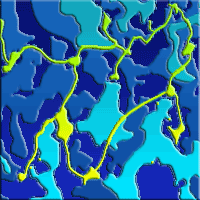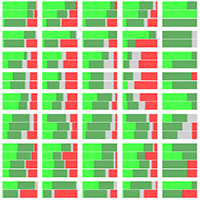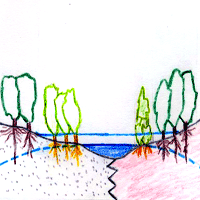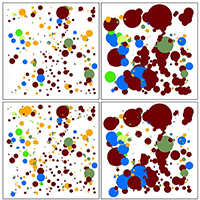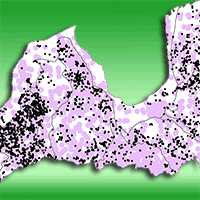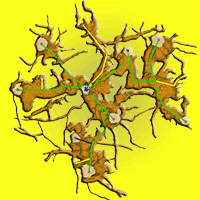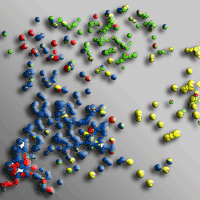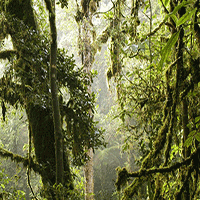
Spatial distribution pattern of Mezilaurus itauba (Meins.) Taub. Ex mez. in a seasonal forest area of the southern Amazon, Brazil
Alexandre Ebert , Reginaldo Brito Da Costa, Gilvano Ebling Brondani
iForest - Biogeosciences and Forestry, Volume 9, Issue 3, Pages 497-502 (2016)
doi: https://doi.org/10.3832/ifor1427-008
Published: Jan 25, 2016 - Copyright © 2016 SISEF
Research Articles
Abstract
Spatial analysis of forest tree distribution is a powerful tool to respond to basic ecological questions, and represent a useful support to strategies of genetic conservation and sustainable management practices of forest resources. Spatial analysis techniques combined with the use of Geographical Information Systems have been commonly applied to the study of stochastic processes in order to determine the existence of clusters to be related to microenviromental conditions and/or genetic factors. The present study focused on the distribution patterns of individuals of Mezilaurus itauba in a seasonal forest of the southern Amazon, with the aim of providing information about the spatial arrangement of these species at the juvenile and adult stages. Ripley’s K function with radius of 10, 20 and 30 m was used to describe spatial distribution patterns. The hypothesis of complete spatial randomness (CSR) of individuals was tested by constructing confidence envelopes for the Ripley’s K function through Monte Carlo simulations using a Poisson homogeneous process. The results obtained suggest a general random distribution of individuals, though a tendency to clustering at close distances was detected for individuals classified as adults (DBH > 50 cm). Contrastingly, a completely randomized spatial pattern was found for juveniles trees (DBH < 50 cm). Our results provide a useful baseline for the development of sustainable management plans and conservation of Mezilaurus itauba, as well as for other economically-exploited, native tree species in the southern Amazon forest.
Keywords
Ripley’s K Function, Spatial Distribution Patterns, Forest Management, Conservation of Biodiversity, Horizontal Structure
Authors’ Info
Authors’ address
Reginaldo Brito Da Costa
Gilvano Ebling Brondani
College of Forestry Engineering, Federal University of Mato Grosso, Cuiabá (Brazil)
Corresponding author
Paper Info
Citation
Ebert A, Brito Da Costa R, Brondani GE (2016). Spatial distribution pattern of Mezilaurus itauba (Meins.) Taub. Ex mez. in a seasonal forest area of the southern Amazon, Brazil. iForest 9: 497-502. - doi: 10.3832/ifor1427-008
Academic Editor
Chris Eastaugh
Paper history
Received: Aug 15, 2014
Accepted: Jan 22, 2016
First online: Jan 25, 2016
Publication Date: Jun 01, 2016
Publication Time: 0.10 months
Copyright Information
© SISEF - The Italian Society of Silviculture and Forest Ecology 2016
Open Access
This article is distributed under the terms of the Creative Commons Attribution-Non Commercial 4.0 International (https://creativecommons.org/licenses/by-nc/4.0/), which permits unrestricted use, distribution, and reproduction in any medium, provided you give appropriate credit to the original author(s) and the source, provide a link to the Creative Commons license, and indicate if changes were made.
Web Metrics
Breakdown by View Type
Article Usage
Total Article Views: 49423
(from publication date up to now)
Breakdown by View Type
HTML Page Views: 41370
Abstract Page Views: 3108
PDF Downloads: 3623
Citation/Reference Downloads: 46
XML Downloads: 1276
Web Metrics
Days since publication: 3617
Overall contacts: 49423
Avg. contacts per week: 95.65
Citation Metrics
Article Citations
Article citations are based on data periodically collected from the Clarivate Web of Science web site
(last update: Mar 2025)
Total number of cites (since 2016): 6
Average cites per year: 0.60
Publication Metrics
by Dimensions ©
Articles citing this article
List of the papers citing this article based on CrossRef Cited-by.
References
Estrutura da vegetação em diferentes ambientes na resex do Rio Cajari: interações solo-floresta e relações com a produção de castanha [Structure of the vegetation in different environments in the Resex Rio Cajari: forest-soil interaction and relationships with chestnut production]. Ph.D. thesis, Universidade Federal de Pernambuco, Recife, PE, Brazil, pp. 150. [in Portuguese]
Gscholar
Ecology: from individuals to ecosystems (4th edn). Blackwell, Oxford, UK, pp. 752.
Gscholar
Análise dos padrões espaciais de árvores em quatro formações florestais do estado de São Paulo, através de análises de segunda ordem, como a função K de Ripley [Spatial pattern analysis of trees of four forest communities in southeastern Brazil using the Ripley’s K function]. Dissertação de Mestrado, Escola Superior de Agricultura Luiz de Queiroz, Piracicaba, SP, Brazil, pp. 79. [in Portuguese]
Gscholar
Forest Biodiversity - Earth’s living treasure. Secretariat of the Convention on Biological Diversity, Montreal, Canada, pp. 48.
Gscholar
Flora arbustivo-arbórea de trecho de mata mesófila semidecídua, na estação ecológica de Ibicatu, Piracicaba, SP, Brazil [Shrub and tree flora of the semideciduous forest section in the ecological station of Ibicatu, Piracicaba, SP, Brazil]. Hoehnea 22: 47-59. [in Portuguese]
Gscholar
Análise da estrutura espacial horizontal de uma floresta de terra firme da Amazônia [Analysis of horizontal spatial structure of an Amazonian terra firme forest]. Ph.D. Thesis, Universidade Federal do Paraná, Curitiba, PR, Brazil, pp. 179. [in Portuguese]
Gscholar
Análise espacial de dados geográficos [Spatial analysis of geographic data]. EMBRAPA, Brasilia, DF, Brazil, pp. 190. [in Portuguese]
Gscholar
Estrutura e diversidade de comunidades florestais [Structure and diversity of forest communities]. In: “Ecologia de Florestas Tropicais do Brasil (2nd edn)” (Martins SV ed). Editora UFV, Viçosa, MG, Brazil, pp. 294-325. [in Portuguese]
Gscholar
Forest management and climate change: a literature review. Food and Agriculture Organization of the United Nations, Rome, Italy, pp. 46.
Gscholar
Manual técnico da vegetação brasileira: sistema fitogeográfico, inventário das formações florestais e campestres, técnicas e manejo de coleções bot’nicas, procedimentos para mapeamentos [Technical manual of the Brazilian vegetation: phytogeographic system, inventory of forest and grasslands, technical and management of botanical collections, procedures for mapping] (2nd edn). IBGE - Instituto Brasileiro de Geografia e Estatística, Rio de Janeiro, RJ, Brazil, pp. 275.
Gscholar
A new method to measure spatial association for ecological count data. Ecoscience 9 (2): 133-141.
Gscholar
Análise da estrutura diamétrica do sassafrás (Ocotea odorifera (Vell. ) Rohwer) em fragmentos florestais no município de Fazenda Rio Grande. Paraná, PR, Brazil [Analysis of diameter structure of sassafras (Ocotea odorifera (Vell.) Rohwer) in forest fragments in the municipality of Fazenda Rio Grande. Paraná, Paraná, Brazil]. Ambiência 3: 167-181. [in Portuguese]
Gscholar
A Amazônia frente às mudanças no uso da terra e do clima global e a import’ncia das áreas protegidas na mitigação dos impactos: um estudo de modelagem numérica da atmosfera [The Amazon in the face of land cover and global climate changes and the importance of protected areas in mitigation of impacts: a study of numerical modeling of the atmosphere]. Acta Geográfica pp. 31-48. [in Portuguese]
Gscholar
Distribuição diamétrica, espacial, características ecológicas e silviculturais de Mezilaurus itauba (Meisn.) Taub. ExMez, na floresta do estado do Amapá (Flota/AP), Brasil [Diameter and spatial distribution, ecological and silvicultural characteristics of Mezilaurus Itauba (Meisn.) Taub. ExMez in the Amapá State Forest (Flota / AP), Brazil]. In: Proceedings of the “V Simpósio Latino Americano Sobre Manejo Floretal”. Santa Maria (RS, Brazil) 22-24 Sep 2015, pp. 526-533.
Online | Gscholar
Padrões Espaciais de Espécies Arbóreas Tropicais [Spatial patterns of tropical tree species]. In: “Ecologia de Florestas Tropicais do Brasil” (Martins SV ed). Editora UFV, Viçosa, MG, Brazil 1: 326-352. [in Portuguese]
Gscholar

